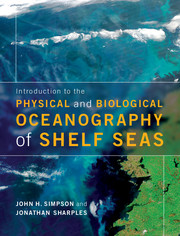Book contents
- Frontmatter
- Contents
- Preface
- Acknowledgements
- Guide to the book and how to make the best use of it
- Symbols
- 1 Introduction to the shelf seas
- 2 Physical forcing of the shelf seas: what drives the motion of ocean?
- 3 Response to forcing: the governing equations and some basic solutions
- 4 Waves, turbulent motions and mixing
- 5 Life in the shelf seas
- 6 Seasonal stratification and the spring bloom
- 7 Interior mixing and phytoplankton survival in stratified environments
- 8 Tidal mixing fronts: their location, dynamics and biological significance
- 9 Regions of freshwater influence (ROFIs)
- 10 The shelf edge system
- 11 Future challenges in shelf seas
- Glossary
- Answers to chapter problems
- References
- Index
- Plate section
5 - Life in the shelf seas
Published online by Cambridge University Press: 05 June 2012
- Frontmatter
- Contents
- Preface
- Acknowledgements
- Guide to the book and how to make the best use of it
- Symbols
- 1 Introduction to the shelf seas
- 2 Physical forcing of the shelf seas: what drives the motion of ocean?
- 3 Response to forcing: the governing equations and some basic solutions
- 4 Waves, turbulent motions and mixing
- 5 Life in the shelf seas
- 6 Seasonal stratification and the spring bloom
- 7 Interior mixing and phytoplankton survival in stratified environments
- 8 Tidal mixing fronts: their location, dynamics and biological significance
- 9 Regions of freshwater influence (ROFIs)
- 10 The shelf edge system
- 11 Future challenges in shelf seas
- Glossary
- Answers to chapter problems
- References
- Index
- Plate section
Summary
Much of the physics in the preceding chapters can be traced back to the fundamentals of fluid flow encapsulated in the equations of motion and continuity, along with the eddy description of turbulence. By contrast, describing the basics of life in the sea presents us with the difficulty of trying to distil a broad set of concepts from a system which is inherently very complex. Our experience of working at sea alongside biologists has been stimulating and fruitful, but there is always a tension: physicists can get exasperated at the complexity of the systems that biologists like to describe, while the biologists roll their eyes at the physicists’ insistence on boiling problems down to as simple a level as possible. In this chapter we will take more of a physicist's view of biology in the ocean, focusing mainly on those aspects of the biology that are relevant to understanding how organisms’ access to resources and growth are controlled by the structure and motion of the fluid environment.
Broadly, we are aiming to understand how organic compounds are produced in the ocean, and their fate. The schematic illustration of Fig. 5.1 provides us with a framework for the chapter; you could also have a look at the final schematic in Fig. 5.19 if you would like some idea of the details that we will be adding to this framework. We will begin by describing the fundamental biochemistry that lies at the heart of the growth of the autotrophs, the single-celled, photosynthesising phytoplankton which produce the organic matter and so power both the rest of life in the ocean and the cycling of carbon. In contrast, the heterotrophs consume organic material, either recycling it back to inorganic matter or passing it further up the food chain by being food for larger heterotrophs. Heterotrophs are much more varied in form and in their methods used for finding and consuming their prey, so instead of trying to detail this variety we will identify their broad roles in the ecosystem and some of the constraints that life in a turbulent fluid imposes on them. The biological processes that we will describe are in general common to the open ocean and to the shelf seas. We will use shelf sea examples to illustrate the processes, and identify where the important contrasts are between shelf and open ocean biology.
- Type
- Chapter
- Information
- Publisher: Cambridge University PressPrint publication year: 2012



